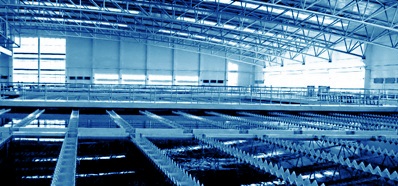Flotators
Flotation Device
Flotation devices are structures shaped like tanks or chambers designed for the separation of solid fine particles in liquids or the extraction of valuable components by attracting them to introduced gas bubbles, oil droplets, and other elements suspended in the liquid.
The key factor affecting the efficiency of flotation machines is the pulp aeration level. Pulp aeration is determined by the amount of air passing through a unit volume of pulp per unit time (liters/m3*min). There are several types of pulp aeration, which define different types of flotation machines:
- Mechanical flotation: involves mixing, suction, and dispersion of air using an impeller. Air is broken into individual bubbles under the influence of water vortices;
- Pneumatic-mechanical flotation: air is introduced into the pulp through porous partitions or tubes, and pulp dispersion and mixing are performed by an impeller;
- Pneumatic flotation: pulp mixing and aeration are achieved by supplying compressed air through aerators of various designs;
- Vacuum flotation machines and compressor flotation machines: aeration is achieved by releasing dissolved gases from the pulp;
- Electroflotation machines: liquid aeration is accomplished by bubbles generated during electrolysis;
- Centrifugal flotation machines;
- Flotation machines with liquid jet aeration.
Characteristics of flotation machines include:
- Chamber capacity;
- Throughput capacity;
- Impeller drive motor power;
- Specific air consumption;
- Working components such as elevator, chamber, impellers;
- Pipes for concentrate discharge.
Flotation devices can be either direct-flow, consisting of a trough with transverse partitions, or chambered, consisting of individual chambers with intermediate boxes for adjusting the pulp level.
The characteristics of flotation machines may vary depending on their type. For mechanical and pneumatic-mechanical machines, the chamber volume can range from 0.14 to 70 m³, pulp flow rates from 0.20 to 130 m³/min, and specific power consumption from 0.85 to 2.80 kW/m³.
To ensure the effective operation of flotation machines, working components such as pulp feed elevators, chambers, rotors, waste discharge pipes, and concentrate discharge pipes are also required.
Types of machines, such as direct-flow and chambered, differ in the nature of longitudinal pulp movement:
- Direct-flow machines consist of a trough divided by transverse partitions creating individual compartments. The upper part of the partitions is below the pulp level, and at the discharge end of the compartment, there is a box for adjusting the pulp level;
- Chambered machines consist of individual chambers separated by an intermediate box. The pulp moves from one chamber to another, and the box allows adjusting the pulp level by changing it across the chambers.
Thus, flotation machines offer diverse technologies with various aeration methods and structural features, ensuring effective separation of solid particles in liquids.
DAF DAFM – Pressure air flotation unit
| Name | Indicator | Note |
| DAF DAFM | 1 – 12 m length, 1-100 m3/h capacity
1.5 – 15 kW power |
|

DAF CAFM – Cavitation pressure air flotation unit
| Name | Indicator | Note |
| DAF СAFM | 1 – 20 m length, 1-500 m3/h capacity
1.5 – 15 kW power |
|

JF FM – Pressure air jet flotation unit
| Name | Indicator | Note |
| JF FM | 1 – 14 m length, 10-250 m3/h capacity
0.5 – 18 kW power |
|
JF FM Smell water – Pressure air flotation unit for foul-smelling wastewater
| Name | Indicator | Note |
| JF FM | 1 – 12 m length, 10-250 m3/h capacity
0.5 – 20 kW power |
|

DW FM – Double-action pressure air flotation unit
| Name | Indicator | Note |
| DW FM | 1 – 12 m length, 1-50 m3/h capacity
0.5 – 7.5 kW power |
|

VS FM – Vertical pressure air flotation unit
| Name | Indicator | Note |
| VS FM | d=800-4000 mm, 1-50 m3/h capacity
0.5 – 9.5 kW power |
|




